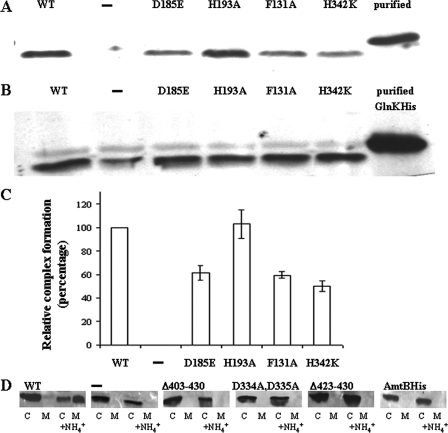FIG. 2.
Complex formation between AmtB variants and GlnK or GlnB. Cultures of an R. capsulatus amtB mutant strain (RCAY63) alone (−) or complemented with a plasmid carrying a glnKamtB operon encoding wild-type AmtB (WT) or various AmtB variants (D185E, H193A, F131A, and H342K) were grown under N2-fixing conditions. NH4Cl (1 mM) was added 15 min prior to harvest. The membrane fractions (A) and whole-cell extracts (B) of cultures exposed to NH4Cl (1 mM) were subjected to SDS-PAGE (5 μg of total protein loaded per well) and immunoblotting with anti-GlnK antibody. In the last well, 30 ng of purified GlnKHis was added. The loaded variants with which GlnK interacts are indicated above the panels. Two independent experiments were done, and the amount of GlnK complexed with the variant AmtB was quantified relative to wild-type AmtB (C). Additional strains were examined for complex formation between GlnK and AmtB variants by visualizing the ammonium-induced membrane sequestration of GlnK by using fractionation and immunoblotting. Two parallel cultures of each strain were grown under N2-fixing conditions. The strains examined consisted of an R. capsulatus amtB mutant strain (RCAY63) alone (−) or complemented with a plasmid carrying a glnKamtB operon encoding wild-type AmtB (WT) or various AmtB variants (Δ403-430, D334A D335A, Δ423-430, and AmtBHis). NH4Cl (1 mM) was added to one of the parallel cultures 15 min prior to harvest. Cytoplasmic (C) and membrane (M) fractions were subjected to SDS-PAGE (5 μg of total protein loaded per well) and immunoblotting with anti-GlnK. The top of the panel indicates the AmtB variant present (D).

